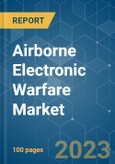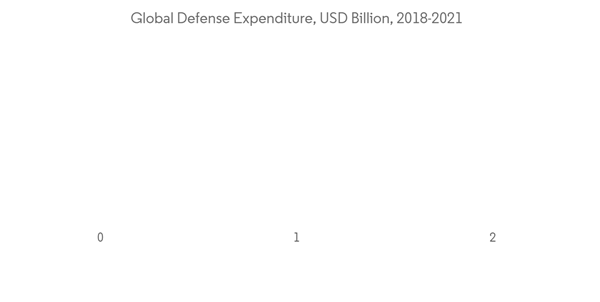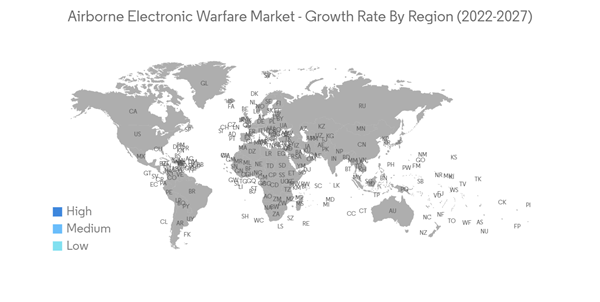Despite the impact of the COVID-19 pandemic on the global economy, the military expenditure of several countries remained constant, if not higher, than in previous years. Global military expenditure was USD 1.98 trillion in 2020 and was increased by 0.7% to USD 2.1 trillion in 2021. The supply chain disruption caused by the pandemic had a slightly negative impact on the airborne electronic warfare market. This disruption caused mild disruptions to the ongoing activities of product innovation and manufacturing for a brief period in 2020. However, as the market has recovered from the pandemic, the airborne electronic warfare market has gained a stable position in the market.
The increasing demand for intelligence, surveillance, and reconnaissance (ISR) systems from various armed forces around the world is anticipated to drive the growth of the airborne electronic warfare market over the coming years.
Advancements in technology in the areas of enhanced stealth capabilities of aircraft, communication jamming technology, and advanced air defense systems are generating demand for air electronic protection and support measures in combat and non-combat aircraft.
Airborne Electronic Warfare Aircraft Market Trends
Growth in the Global Defense Expenditure
The market studied is likely to grow steadily during the forecast period. This is due to growing investments in obtaining faster and more secure airborne electronic warfare capabilities for the global armed forces. Countries are progressively adopting these systems for better threat detection capabilities, electromagnetic attack (EA), electromagnetic warfare support (ES), and electromagnetic protection (EP). On account of capability enhancement initiatives undertaken by global military powerhouses such as the United States, the United Kingdom, China, and India, the high demand for airborne electronic warfare systems is expected to drive the market during the forecast period.In addition to the traditional demand from the US and European markets, several countries in Asia-Pacific, the Middle East, and Latin America focus on augmenting their airborne electronic warfare and combat support capabilities. In this regard, several military ISR system development, procurement, and modernization programs are currently underway to enhance the combat capabilities of the armed forces. These programs are supported by colossal defense budgets.
In recent years, countries in these regions have placed orders for new-generation platforms and equipment that incorporate airborne electronic warfare systems while several development programs are underway. These programs are expected to run during the forecast period. For instance, in 2021, world military expenditure surpassed the USD 2 trillion mark for the first time, reaching USD 2113 billion. Global spending in 2021 was 0.7% higher than in 2020 and 12% higher than in 2012.
The development and procurement of such platforms and equipment require massive defense spending from countries since they are expensive. Thus, the growth in defense spending is expected to drive the growth of the market in the coming years.
The North America Region is Anticipated to Dominate the Market During the Forecast Period
With the presence of major military aircraft manufacturers, such as Boeing, Northrop Grumman, and Lockheed Martin, and a huge defense budget, the United States is currently the largest market for electronic warfare aircraft. In order to maintain EW capabilities and support the future development of the Air Force, the United States is investing in enhancing EW capabilities. The Air Force is currently upgrading the EC-130H Compass Call EW payloads. It also has plans to procure 12 EC-37s during the next decade. Also, according to the Congressional Budget Office, the Air Force procurement cost is estimated to increase from USD 28 billion in 2020 by 11% to USD 31 billion in 2024. This increase in the procurement of various aircraft and UAV programs is expected to generate demand in North America for the airborne electronic warfare market. However, the Asia-Pacific region is anticipated to witness the highest CAGR during the forecast period due to increasing military spending by the countries in the Asia-Pacific region owing to various territorial issues and political conflicts across the land and sea borders. This is generating a need for advanced air surveillance systems to enhance survivability across borders, thereby generating demand for EW attack, protection, and support systems.Airborne Electronic Warfare Aircraft Market Competitor Analysis
Lockheed Martin Corporation, Raytheon Company, BAE Systems PLC, Saab AB, and Northrop Grumman Corporation are some of the prominent players in the airborne electronic warfare market. In addition to the major manufacturers of electronic warfare systems, several regional manufacturers support various aircraft programs with their EW suites. Increasing investments in advanced EW solutions can be integrated into many aircraft programs. This will provide better threat identification and countermeasure capabilities, which is likely to fuel the growth trajectory of the market during the forecast period.Additional benefits of purchasing the report:
- The market estimate (ME) sheet in Excel format
- 3 months of analyst support
This product will be delivered within 2 business days.
Table of Contents
Companies Mentioned (Partial List)
A selection of companies mentioned in this report includes, but is not limited to:
- Lockheed Martin Corporation
- Raytheon Company
- L3Harris Technologies Inc.
- BAE Systems PLC
- ASELSAN AS
- Northrop Grumman Corporation
- Thales Group
- Saab AB
- Leonardo SpA
- Elbit Systems Ltd
- Israel Aerospace Industries Ltd
- Terma Group










